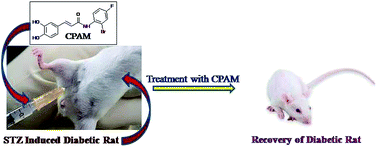N-(2-Bromo-4-fluorophenyl)-3-(3,4-dihydroxyphenyl)-acrylamide (CPAM), a small catecholic amide as an antioxidant, anti diabetic and antibacterial compound†
Abstract
The trans conformation of N-(2-bromo-4-fluorophenyl)-3-(3,4-dihydroxyphenyl)-acrylamide (CPAM), a small catecholic amide with halogen moieties, may be used as an anti diabetic compound. This newly synthesized CPAM was found to reduce blood sugar levels about 3 fold in streptozotocin (STZ) induced diabetic rats at a dose of 2.5 mg kg−1 body weight after 15 days of treatment. A post diabetic study revealed that CPAM could normalize alkaline phosphatase (ALP), acid phosphatase (ACP) and prostatic ACP values. The ED50 and ED90 values of CPAM against rats were determined as 1 mg kg−1 and 2.5 mg kg−1 body weight respectively. No adverse toxicological effects of CPAM were noted on the body weight, blood, liver or kidneys of the experimental animals. Furthermore, it was observed from histopathological results that CPAM had no unfavourable effects on the vital organs of the rats. The presence of CPAM in the blood serum of tested rats also ensured its wide range of applicability. In addition, the synthetic CPAM compound showed antibacterial activity against Mycobacterium smegmatis, Pseudomonas aeruginosa, Staphylococcus aureus and clinically drug resistant S. aureus (MRSA) strains. Thus, CPAM might be useful for the treatment of secondary infections which are common for diabetic individuals.


 Please wait while we load your content...
Please wait while we load your content...